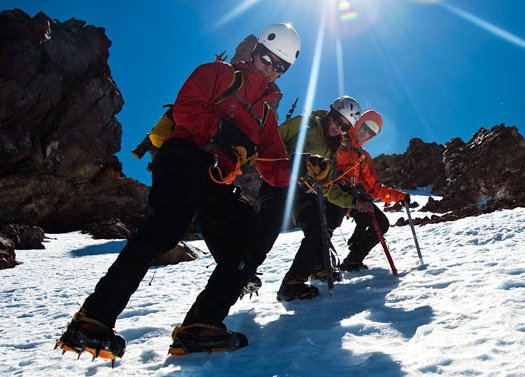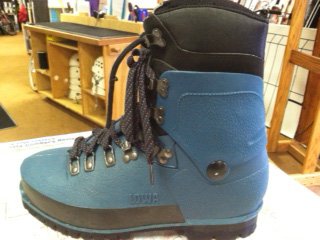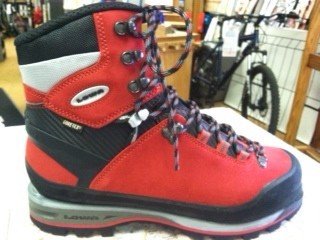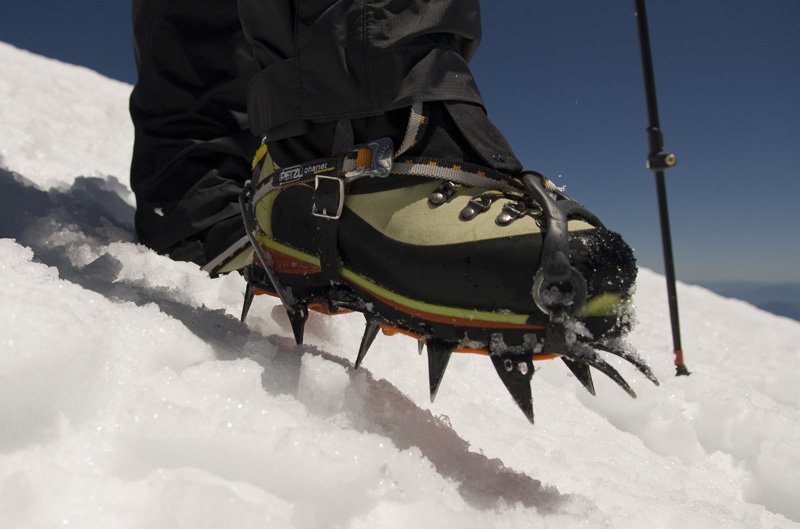What boots do I need to climb Mt. Shasta?




Probably the most frequent gear question we receive revolves around appropriate footwear for climbing Mt. Shasta. For many climbers, this may be their first chance to use a rigid, technical mountaineering boot. Footwear is likely the most critical piece of equipment for the climb, it can make or break a successful summit attempt and affect the safety and comfort of your ascent.
There are a few choices of boot styles available for mountaineering. We require something that is stiff with a rigid sole that provides a secure attachment to the crampons we will be wearing on summit day. Anything less and we run the risk of the crampons not being adequately secured as well as the possibility of rolling our ankles on the steep, rugged terrain we encounter on the mountain. And warmth is a factor as well as waterproofness. Early season climbs will be completely on snow and temperatures can be cold on the upper mountain.
All-around technical mountain boots are generally preferred. The Scarpa Mont Blanc, or La Sportiva Nepal Evo are good picks in that class. These versatile general-purpose boots are guide favorites and are better for climbs that have extended snow and ice, including at basecamp – such as May and June climbs on Shasta. If purchasing a first mountain boot, one in this class is a good buy. This category of boots includes full leather models to boots built with a wide variety of high tech materials. The advantage is it’s lighter weight and they are generally better for walking on trails and dry ground. This style boot is best for 2-3 day summit climbs in the summer when the lower mountain may be snow free and the temperatures are milder. The Fifth Season rents several models to accommodate a wide variety of foot shapes.
Lightweight alpine boots, like the Scarpa Charmoz or LaSportiva Trango Cube do not not provide enough warmth in very cold early season conditions, do not typically provide enough ankle support for extended cramponing, and are not compatible with step-in crampons – only hybrids or strap-ons. These are generally sufficient for later season Avalanche Gulch trips, and Clear Creek or North Side trips, where only a relatively smaller portion of the trip will be spent on snow, and the majority of the approach hike and basecamp area is dry. Summer alpine climbs/scrambles in the Sierra or North Cascades would be another good application.
Supergaiter boots are a newer class of boot. They are a single boot with a permanently attached outer gaiter that extends down to the boot sole, adding more warmth and waterproofing than a removable gaiter. These would work great for early season trips in general, but might be a bit too warm for late season trips. They are also harder to dry out than other types. Good examples for Shasta might include the Scarpa Phantom Tech or La Sportiva G5. Please note that there are also double supergaiter boots, but these would be used in very cold climates, like an Everest, Denali, or Antarctica trip, and would not be appropriate for Shasta, except during the coldest winter trips.
We realize there is a lot of apprehension about renting a boot for a big adventure like climbing Mt. Shasta. We at SMG will be there to help with the fitting process to assure that you have the right boot for your foot profile, to the best of our ability. This along with the superior selection of high quality products that is available for rent or purchase at The Fifth Season guarantees we will have the right products for your climb. Probably 90% of our climbers rent boots along with crampons and ice axe and we truly have very few fit or blister issues.
What doesn’t work? Hiking and backpacking boots are not adequate for the climb. Same with Whites, military style, or work/hunting boots. They are generally too soft and flexible which allows the crampons to slide or pop off. As well, the terrain we cover on an alpine climb is rugged; there are no trails above treeline, our packs are heavy, and the added support of the boot will protect our ankles from injury. Just last weekend SMG guides assisted in the rescue of a climber with a broken ankle due to wearing light hikers.
Mountaineering requires specialized equipment and additional gear. We realize this can present many questions and concerns for new climbers. Please don’t hesitate to contact us with your gear (or any other) questions, we’re happy to assist!
